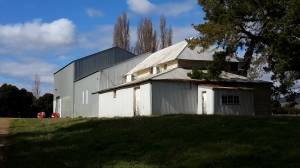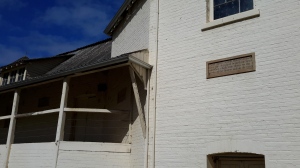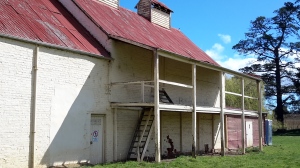The shuffling walk down 1 Acre Lane with the wheelie bins was well worth it. The old lady answered my many questions before she continued on to her house when I stopped to admire the first of many extraordinary buildings.
When I look back over this two day walk along the Derwent River, finding an historic precinct at the end of a dusty lane was my greatest joy. An absolute treasure. In Europe such a place would attract hundreds of coaches disgorging thousands of people each day to visit. Yet in Bushy Park Tasmania, I was the only visitor. Extraordinary. Some of my blog followers are brilliant photographers and would, if they visited, create amazing pictures. I hope my photos are sufficient to whet everyone’s appetite for a visit and to have their own experience of this historic site.
The precinct contains an innovative and more recent initiative – a Junior Angling Pond. Perhaps fishing is the main hobby of locals and what better way to lure new devotees than to offer children their own safe experience.
The buildings had no or limited signage, therefore identifying the purpose of most was impossible for me.
The photo below looks like a large unusual house but apparently this was the bakery feeding the hundreds of workers involved with the hop industry in the past.
The most surprising structure was, what is now known as, the Text Kiln, built in 1867. As I approached the building I did not know this name or the year. Immediately I loved the shapes of the structures then suddenly I was stunned see a sandstone plaque embedded high up on a wooden wall. This was a biblical text. And nearby was a second text. My mouth dropped open; I wrinkled my forehead and shook my head. What am I seeing? What is going on here? In this remote location, clearly the early hop growers placed a great deal of importance on the Christian scriptures. I wondered if this text indicated a puritanical god-fearing way of living in the 19th century in Bushy Park. What was that community like?
Beneath a window one text offers: ‘God so loved the world that he gave his only begotten son that whosoever believeth in him should not perish but have everlasting life’. In a triangular alley another plaque exhorts us to ‘Have faith in God’.
As I walked around the building, I saw many more texts .
In all, approximately 13 different texts exist on three sides of this magnificent building.
Eventually I left the Text Kiln and wandered further around the precinct.
The old lady, owner of the wheelie rubbish bins, lived on-site in the red-roofed house.
I guess the red bricks have been painted over in the building named the Red Brick Kiln, shown in the photos below.
The last building I looked at before following another dirt road to the main road, was the Picil Kiln as pictured below.
I hope to bring friends here with a picnic hamper and perhaps a bottle of bubbly in order to relax and soak in the quietness, and to be pleasantly stunned by the scale and dramatic shapes of the buildings. Perhaps I will see you there one day.





























Looking good! I’d be interested in that picnic!
LikeLike
In 1846 the first hops were brought to the Derwent Valley from Maria Island xxm
LikeLike
Thanks for this additional information – it all helps create the larger picture.
LikeLike
This post (and the Scriptures on the walls) reminded me that in England, there are many historical examples of Protestants / Quakers who established industries/companies as part of social reform. I wondered if Bushy Park had similar origins (and a quick bit of googling revealed that it did). These links say a bit more about similar initiatives over here: https://en.wikipedia.org/wiki/Port_Sunlight and http://www.gresham.ac.uk/lectures-and-events/quakers-business-and-morality. Thanks for another interesting read!
LikeLike
Thank you very much for this additional information – I can now see the gap in my research and I am so grateful for your prompt (I think it is taking me so long to write all the posts that I forgot to research on this particular post). Now I realise that the man who built the Text Kiln, Ebenezer Shoobridge, was a devout Quaker.
LikeLike
It’s an amazing little spot. Did you find the cemetery on top of the hill overlooking Bushy Park? It has amazing views of the whole valley.
LikeLike
No I didn’t. That will be something I will hunt out when I head up there for the picnic. Thanks for the tip.
LikeLike
What a delightful discovery. Thanks for sharing this.
LikeLike
I write because I like writing. Additionally, I write because I forget the details of what I have experienced. My blog is one way of collecting my memories together before they float away. And I am happy to share because some of the places I ‘discover’ are so extraordinary that I know others will be interested. So I am glad you enjoyed the post. Perhaps I will see you there one day when I am picnicking. Stranger things have happened.
LikeLiked by 1 person
A wonderful find! A visual treat. Functional architecture. Much human intervention has marred the landscape, yet some has been triumphant. If I continue reading, will you be showing me a contemporary hop kiln or Oast house that excites me as much as these, I wonder…
LikeLike
Glad you are as excited as I was. The old woman with the wheelie bins said there was a functioning Oast House in the precinct, but since I didn’t know what to look for and never saw any building with people around it, I do not have a photo of a contemporary hop kiln. But maybe we all need to go to this precinct in hop picking time and find it – presumably that’s when people are around.
LikeLike
Pingback: The Derwent River in 1958 | Walking the Derwent River